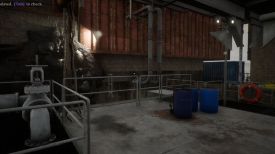|
By flotsam
Waking Tides
AirshipFx
A Lovecraftian piece of
first-person exploration that is largely the effort of a single person,
Waking Tides has upsides as well as downs, and while my major impression
was that it was unbalanced, it largely kept my interest across the two
hours it took me.
It looks and sounds like
Lovecraft should, and you have complete freedom of movement to explore
the various realms. Using a combination of mouse and keyboard, you can
also easily map the keys to suit your interface preferences, which helps
the engagement and the immersion. You can die, unexpectedly and by doing
the next most obvious thing, which (for me) is also in keeping with its
roots. The game’s store page says that it thrives on experimentation,
which could be code for you have to try things in order to determine
what not to try, and that trying again (and again) is essential to
moving on.
The game provides plenty of
clues, including some described as ‘augmented reality’ involving QR
codes and your smart phone (which you can ignore if you want to), and it
will work with you to ensure that a death doesn’t throw you back too
far. Just choose ‘continue’ and try again. There are also plenty of the
sorts of things you need to find to be successful (painkillers for
instance, which are essential to maintain good health, and glowsticks to
ensure you can see what you are doing).
The game autosaves at various
points but there are also save points within the game once you work them
out. You will likely discover them by accident, interacting with them as
just another object, but will then be on the lookout for more of them as
you explore.
I have mentioned the
experimentation aspect, and depending on how you get on, it might be a
significant downside. Die, die and die again with no clue as to why
isn’t objectively appealing. Clearly you need to do something different,
but what is not always apparent. I thought the unbalance was most
pronounced here; clues and indeed outright answers are present for some
things, while other things are left completely in the dark. The endgame
was a latter case in point, and without help I might still be shooting
and wandering and dying willy nilly.
The hotspots are very small, and
some objects are not only small themselves, but can be incredibly hard
to see. Those two aspects combine to produce another possible negative
for players, one that is ameliorated to some extent by the clues you can
find or generate. I certainly wouldn’t have found some items if I hadn’t
known where to look, which again spoke to the unbalance. Make the
hotspots more generous and the items less miniscule and I wouldn’t need
the ‘clue’ that tells me I can find the item over there. Kudos to the
existence of the latter, but give me better capacity to find it myself.
Which might say more about me
and my aging eyesight. Factor that aspect in as you will.
The objective can be
simplistically described as progression from realm to realm by finding
and successfully utilising the portal. Various interactions speak to a
deeper narrative, and references to mysterious codex, scientific
experiments etc., suggest something more, but it didn’t really come
together. The abrupt end didn’t help. That said, the exploration of the
realms and getting from one to another was the main interest for me.
A mixed bag in the end, but one
that I appreciated playing.
I
played on:
OS:
Windows 10, 64 Bit
Processor: Intel i7-9700K 3.7GHz
RAM:
Corsair Dominator Platinum RGB DDR4 32GB
Video
card: AMD Radeon RX 580 8192MB
GameBoomers Review Guidelines
April 2024
design copyright© 2024
GameBoomers
Group
 GB
Reviews Index GB
Reviews Index |






